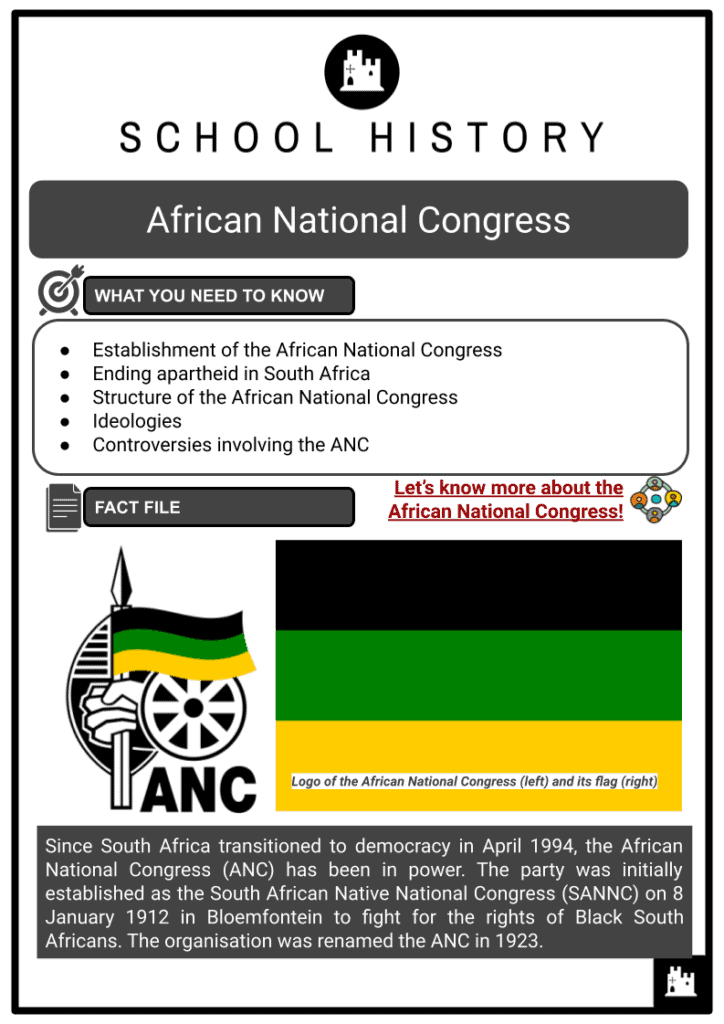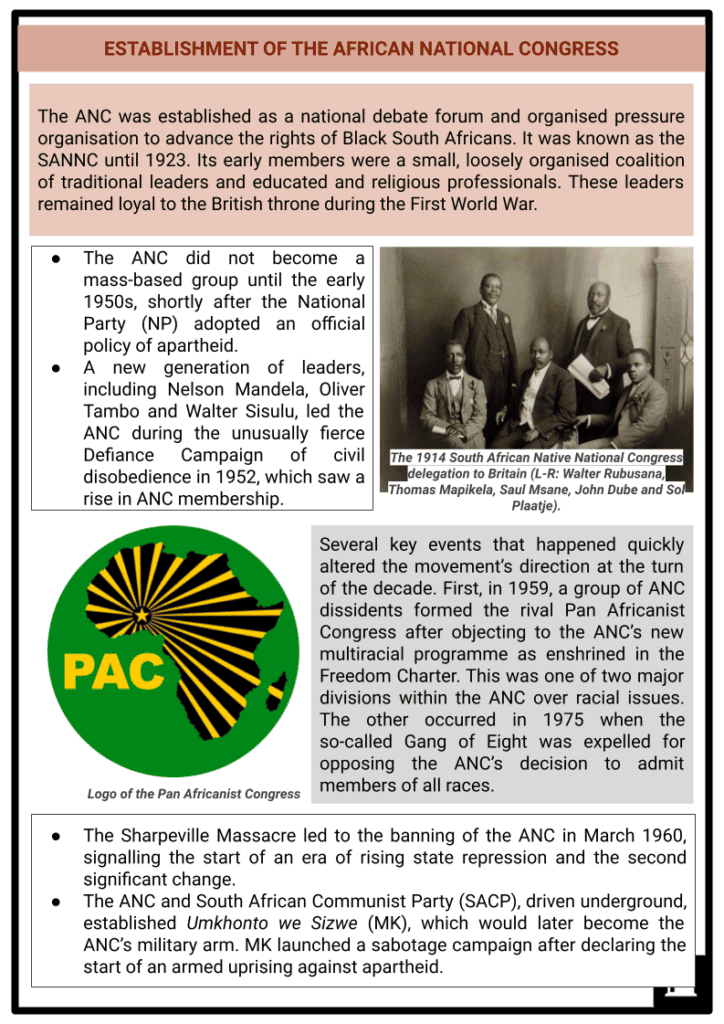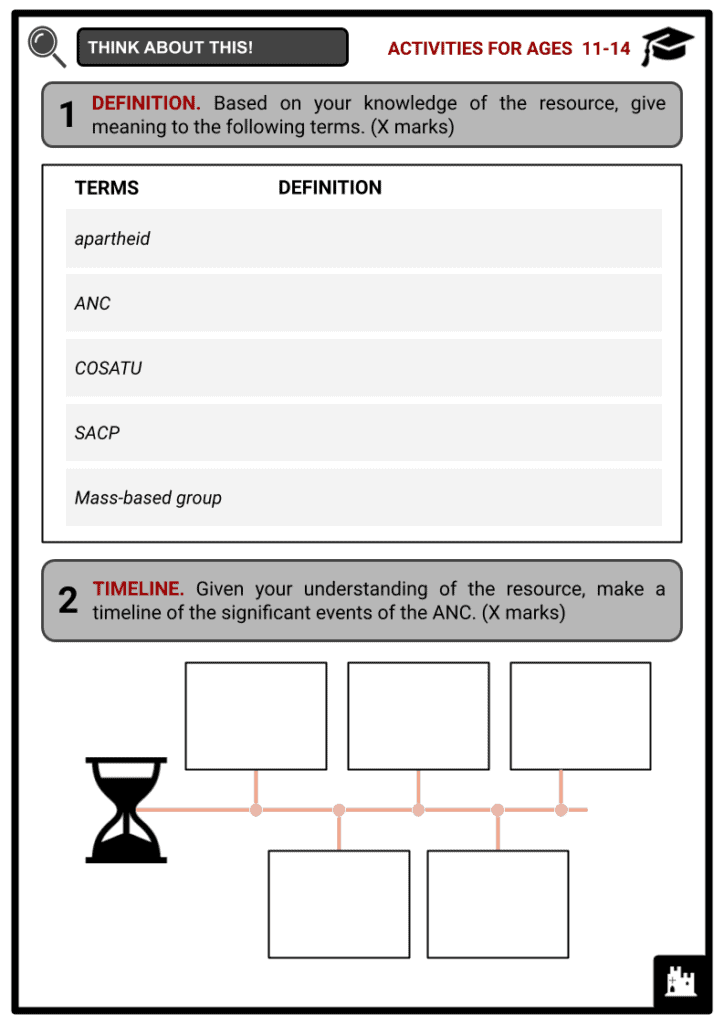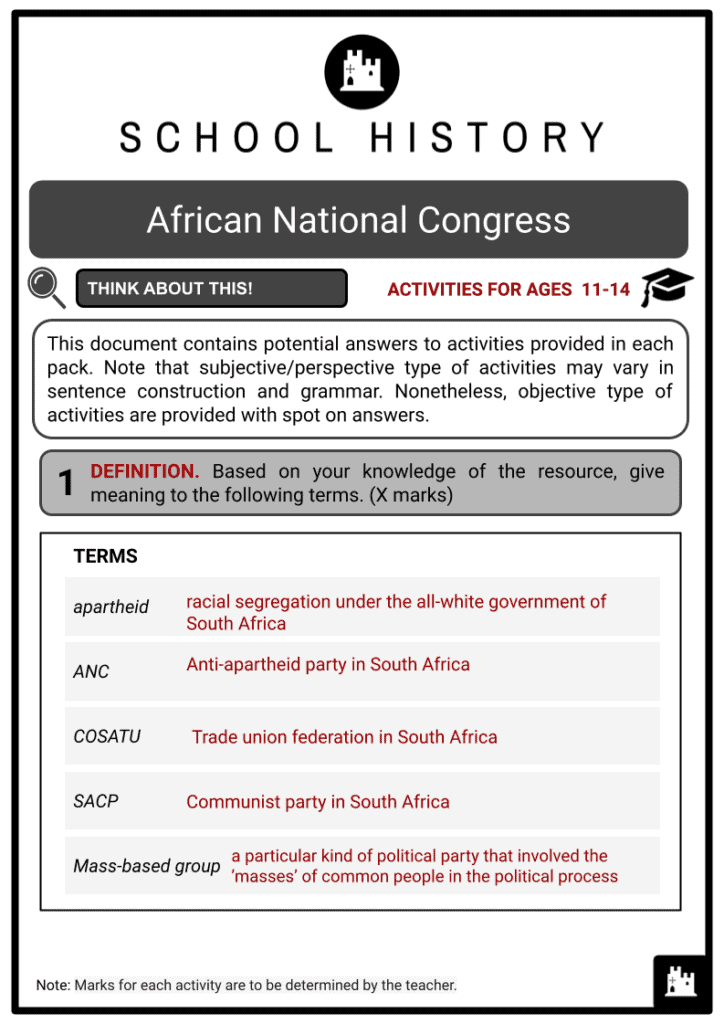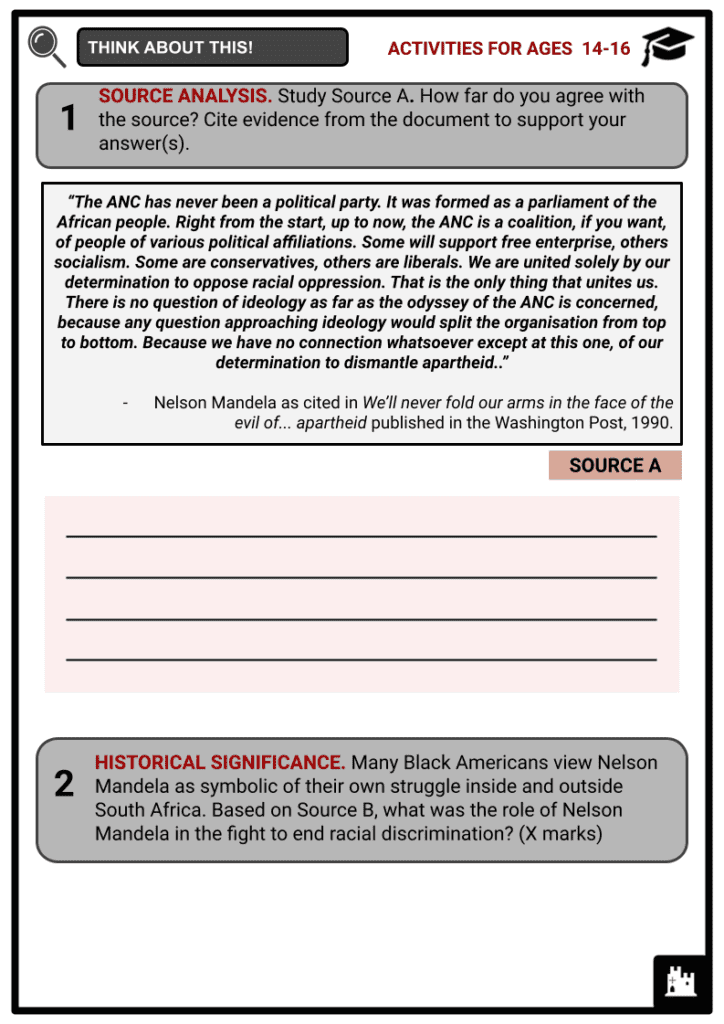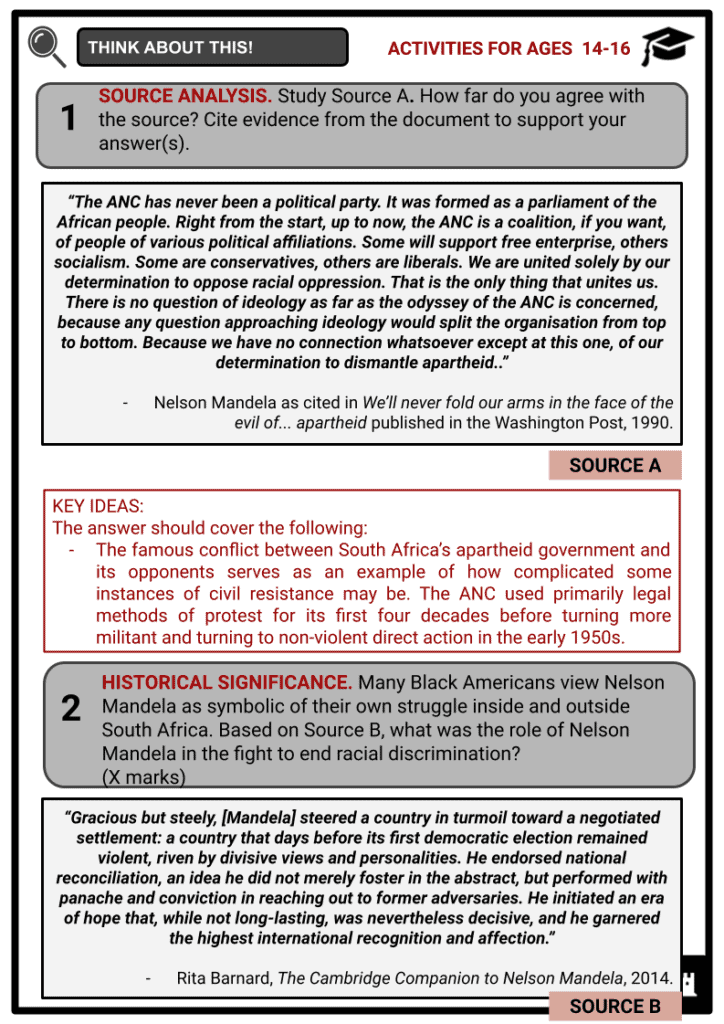African National Congress Worksheets
Do you want to save dozens of hours in time? Get your evenings and weekends back? Be able to teach about the African National Congress to your students?
Our worksheet bundle includes a fact file and printable worksheets and student activities. Perfect for both the classroom and homeschooling!
Summary
- Establishment of the African National Congress
- Ending apartheid in South Africa
- Structure of the African National Congress
- Ideologies
- Controversies involving the ANC
Key Facts And Information
Let’s know more about the African National Congress!
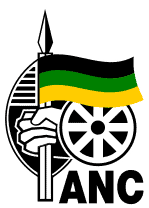
Since South Africa transitioned to democracy in April 1994, the African National Congress (ANC) has been in power. The party was initially established as the South African Native National Congress (SANNC) on 8 January 1912 in Bloemfontein to fight for the rights of Black South Africans. The organisation was renamed the ANC in 1923.
ESTABLISHMENT OF THE AFRICAN NATIONAL CONGRESS
- The ANC was established as a national debate forum and organised pressure organisation to advance the rights of Black South Africans. It was known as the SANNC until 1923. Its early members were a small, loosely organised coalition of traditional leaders and educated and religious professionals. These leaders remained loyal to the British throne during the First World War.
- The ANC did not become a mass-based group until the early 1950s, shortly after the National Party (NP) adopted an official policy of apartheid.
- A new generation of leaders, including Nelson Mandela, Oliver Tambo and Walter Sisulu, led the ANC during the unusually fierce Defiance Campaign of civil disobedience in 1952, which saw a rise in ANC membership.
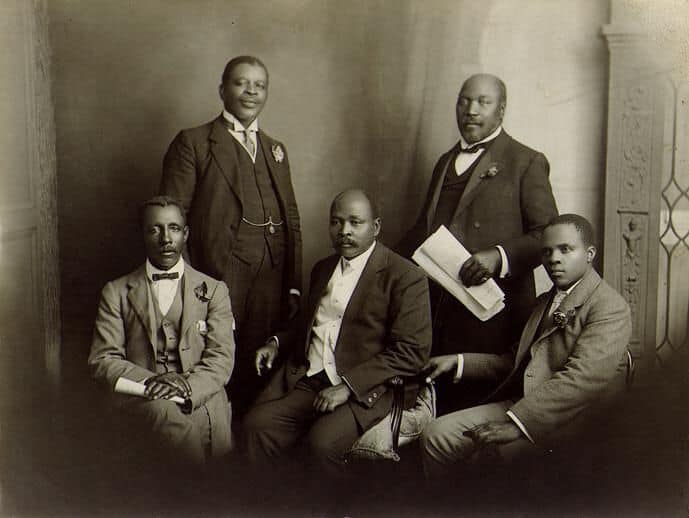
The 1914 South African Native National Congress delegation to Britain (L-R: Walter Rubusana, Thomas Mapikela, Saul Msane, John Dube and Sol Plaatje). - Several key events that happened quickly altered the movement’s direction at the turn of the decade. First, in 1959, a group of ANC dissidents formed the rival Pan Africanist Congress after objecting to the ANC’s new multiracial programme as enshrined in the Freedom Charter. This was one of two major divisions within the ANC over racial issues. The other occurred in 1975 when the so-called Gang of Eight was expelled for opposing the ANC’s decision to admit members of all races.
- The Sharpeville Massacre led to the banning of the ANC in March 1960, signalling the start of an era of rising state repression and the second significant change.
- The ANC and South African Communist Party (SACP), driven underground, established Umkhonto we Sizwe (MK), which would later become the ANC’s military arm. MK launched a sabotage campaign after declaring the start of an armed uprising against apartheid.
- The ANC was forced into exile by 1965 due to the arrest of several of its top leaders in the Rivonia Trial and Little Rivonia Trial. It stayed in exile until 1990 when it was allowed to return. Tambo presided over the ANC for most of this time, with its headquarters initially in Morogoro, Tanzania, and later in Lusaka, Zambia, and with the assistance of Sweden and the Soviet Union.
- Its exile was characterised by considerable internal upheaval in MK, including the Mkatashinga mutinies in 1983–84 and an ever-closer cooperation with the SACP.
- The ANC’s main goal at this time was the destruction of apartheid through the Four Pillars:
- Armed struggle
- Popular mobilisation
- Internal underground
- International isolation of the apartheid regime
- Following the 1976 Soweto Uprising, MK attracted a considerable infusion of new members who were employed to intensify the internal conflict in South Africa. ANC attacks resulted in the first significant civilian casualties.
- Nevertheless, the ANC began secret negotiations about a potential agreement to end apartheid even as the armed attacks persisted.
- These negotiations started with meetings with civil society and business leaders in the middle of the 1980s. Mandela’s meetings with state officials supplemented them while he was imprisoned. On 2 February 1990, the ANC was allowed to resume operations, and its leaders returned to South Africa to start official negotiations.
ENDING APARTHEID IN SOUTH AFRICA
- Between 1990 and 1993, a series of bilateral and multilateral discussions resulted in the abolition of the apartheid system in South Africa. The discussions ended in the adoption a new temporary constitution in 1993 that served as a model for the constitution of 1996. In addition, the ANC liberation movement won South Africa’s first non-racial elections in 1994.
- Even while there had been hints of negotiations in the 1970s and 1980s, things started moving in 1990 when Frederik Willem de Klerk’s government initiated the release of Nelson Mandela from prison, and the ban on the ANC and other political parties was lifted as part of de Klerk’s unilateral reforms.
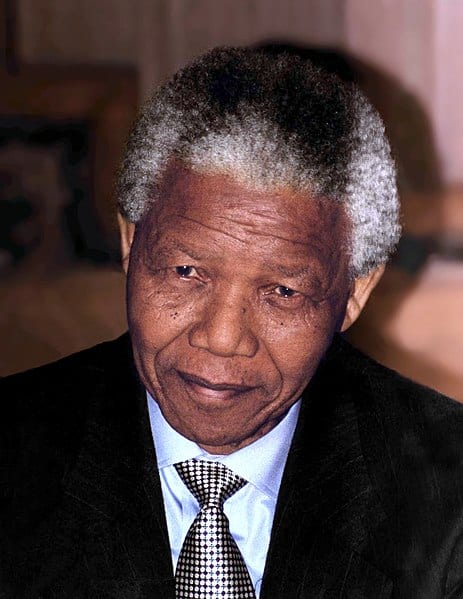
Nelson Mandela was elected as the first Black chief executive in the 1994 election. - The Groote Schuur and Pretoria Minutes, which resulted from bilateral talks about negotiations between the ANC and the government in 1990–1991, laid the groundwork for actual negotiations.
- The National Peace Accord of 1991, later strengthened by the creation of the multi-party Convention for a Democratic South Africa (CODESA), was the first multi-party agreement on the merits of a negotiated settlement. But during CODESA’s second plenary meeting in May 1992, discussions on the constitution-making process, political and cultural self-determination, and regional autonomy stopped.
- The ANC resumed its mass action campaign to gain support from the general public, but after the Boipatong massacre in June 1992, it abruptly ended all negotiations.
- The massacre rekindled long-standing worries about official involvement in political violence, possibly through the employment of a third force supported by the State and intent on destabilisation.
- Political unrest persisted during the negotiations, with attacks by white separatists and extremists coming at irregular intervals and frequent skirmishes between ANC and Inkatha Freedom Party (IFP) followers.
- But after several bilateral negotiations, the ANC and the government signed a new bilateral Record of Understanding in September 1992, paving the way for the eventually fruitful Multi-Party Negotiating Forum from April to November 1993.
- Although the ANC and the ruling NP were the key players in the negotiations, they had difficulty understanding other participating groups, particularly the conservative leaders of the independent homelands and the KwaZulu homeland, as well as left- and right-wing Black groups.
- Most of them ultimately decided to participate in the 1994 elections, but many groups, including the IFP, boycotted the last stages of the negotiations.
STRUCTURE OF AFRICAN NATIONAL CONGRESS
- Every ANC member is part of a local branch, whose members choose the organisation’s policies and leaders. According to the ANC constitution, this is done primarily via electing representatives to the National Conference, which is now held every five years. The group is run between conferences by its 86-member National Executive Committee, chosen at each conference.
- National Conference of the African National Congress
- The ANC held annual national congresses before being outlawed by the South African government in 1960. The ANC conducted its first national conference in 32 years in Durban in 1991, following its lifting of the prohibition.
- National Executive Committee of the African National Congress
- The organisation’s top executive body is the ANC’s National Executive Committee (NEC). It is chosen at the party’s national Convention every five years, and the executive committee chooses a National Working Committee to handle daily decision-making.
- The so-called Top Six officials are the National Executive Committee’s most senior members, with the ANC president at the top.
- At the subnational levels, a symmetrical process is used to elect branch officials at branch general meetings and each of the nine provincial executive committees and regional executive committees at the respective provincial and regional elective conferences, also attended by branch delegates.
What are the Leagues under the ANC?
African National Congress Women’s League (ANCWL)
- The Bantu Women’s League served as a model for the ANCWL, and from the time it was founded through the exile years and into the post-apartheid era in South Africa, it alternated between being the Women’s Section and the Women’s League. The ANCWL was established in 1943, following the ANC’s decision to allow women to join. It allowed Black South African women to participate in the national liberation movement by funnelling their political activities through the ANC.
African National Congress Youth League (ANCYL)
- In Orlando, Soweto, at Walter Sisulu’s home, Anton Lembede, AP Mda, Jordan Ngubane, Nelson Mandela and Oliver Tambo first discussed forming the ANCYL in 1943. Its founders believed that the ANC was dominated by a conservative, older generation that could not connect with younger people. The older generation had attempted to persuade the Union administration to extend equal rights to all through delegations and deputations, but it became increasingly evident that this strategy was useless.
African National Congress Veterans’ League (ANVL)
- ANVL is ANC’s auxiliary political group. Its members are ANC veterans who have been ANC members for at least 40 years and are 60 years or older. To represent veterans in the mainstream ANC’s decision-making, the league was established in December 2009. Nelson Mandela served as the organisation’s honorary life president until Snuki Zikalala took office in October 2017.
What is the ANC’s Tripartite Alliance?
- The ANC, the Congress of South African Trade Unions (COSATU), and the South African Communist Party (SACP) are allies in the Tripartite Alliance.
- The SACP and COSATU have not run in any democratic elections in South Africa, but the ANC holds a majority in the country’s Parliament.
- After Nelson Mandela’s release in 1990, the Alliance was created. The movements opposed the apartheid government’s dominance over the white minority.
- COSATU. South Africa’s COSATU labour union federation. With 21 affiliated trade unions, it was established in 1985 and is the biggest of the nation’s three major labour union federations.
- SACP. It was established in 1921 as the Communist Party of South Africa (CPSA). Still, it strategically disbanded itself in 1950 when the National Party, which was in power at the time, declared communism to be illegal under the Suppression of Communism Act 1950.
IDEOLOGIES
- The ANC takes pleasure in being a diverse church and, like many powerful parties, resembles a catch-all party that accepts a variety of ideologies. Following the complete liberation of the country from all forms of discrimination and national oppression, the post-apartheid ANC continues to consider itself first and foremost as a liberation movement.
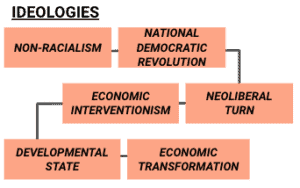
- The Freedom Charter of 1955 is still referred to as the basic policy document of the ANC in this statement.
- However, certain fundamental similarities exist in the mainstream of the organisation’s policy and ideological inclinations.
NON-RACIALISM
- The ANC is devoted to racial equality and opposes any form of racial, tribalistic or ethnic exclusivism or chauvinism.
NATIONAL DEMOCRATIC REVOLUTION
- The ANC pledged to a ‘national democratic revolution - destroying the existing social and economic relationship - will bring with it a correction of the historical injustices perpetrated against the indigenous majority and thus lay the basis for a new, and deeper, internationalist approach’ at the Morogoro Conference, a consultative conference held by the ANC in 1969.
ECONOMIC INTERVENTIONISM
- Since 1994, successive ANC governments have strongly favoured high government involvement in the economy. The 1994 Reconstruction and Development Programme (RDP) paper, which served as both the ANC’s election platform and, under the same name, the government of Nelson Mandela, provided the organisation’s first thorough articulation of its post-apartheid economic policy framework.
NEOLIBERAL TURN
- The Growth Employment and Redistribution (GEAR) initiative, which was maintained by President Thabo Mbeki, Mandela’s successor, succeeded the RDP in 1996 under Mandela’s administration. GEAR has been labelled a neoliberal programme, and COSATU and the SACP have condemned it.
DEVELOPMENTAL STATE
- The idea of a developmental state was reintroduced in South African political discourse in the middle of the 2000s, during Mbeki’s second term, as the country’s economy deteriorated. The planned developmental State was a key component of the ANC’s 2009 election campaign and the current administration’s strategy, which aims to create a ‘capable and developmental’ state.
ECONOMIC TRANSFORMATION
- A Jacob Zuma-aligned ANC group developed the radical economic transformation (RET) policy programme towards the conclusion of his administration. In his State of the Nation address in February 2017, Zuma announced the new emphasis on RET. Later that year, he defined it as entailing ‘fundamental change in the structures, systems, institutions, and patterns of ownership and control of the economy, in favour of all South Africans, especially the poor,’ explaining that it had been adopted as ANC policy and therefore as government policy.
CONTROVERSIES INVOLVING THE ANC
- The most well-known corruption case involving the ANC involves several business bribes in the R55 billion Arms Deal saga. As a result, Schabir Shaik, the legal counsel for Jacob Zuma, the then Deputy President, received a lengthy prison sentence. The National Prosecuting Authority of South Africa later withdrew the accusations against Zuma, the former president of South Africa, due to their delay in bringing charges for fraud, bribery and corruption in the Arms Deal.
- The Scorpions, a multidisciplinary agency that investigated and prosecuted organised crime and corruption and played a significant role in the investigation of Zuma and Shaik, was later abolished by the ANC, which drew criticism for this action.
- Tony Yengeni has lately been implicated with bribing the German business ThyssenKrupp over procuring four corvettes for the SANDF while serving as the ANC’s chief whip and chair of the Parliament’s defence committee.
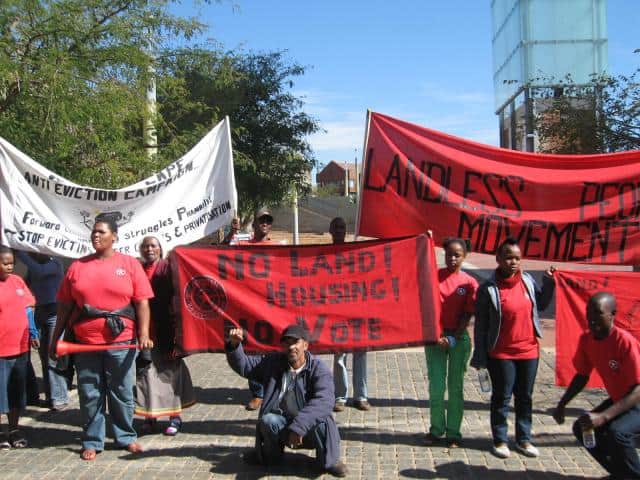
Protesters outside the Constitutional Court in 2009 - The ANC has additionally been charged with leveraging the government and civil society to combat opposition parties like the Democratic Alliance. Numerous grievances and accusations that none of the major parties truly serve the interests of people experiencing poverty have arisen as a result. As a result, the ‘No Land! No House! No Vote!’ The campaign was born, which gained significant attention during the elections. According to a New York Times article, ANC corruption whistleblowers were killed in 2018.
- Late in 2011, the ANC came under fire for passing the Protection of State Information Bill, which opponents claimed would improperly impose restrictions on journalistic freedom.
- ANC-aligned organisations, including COSATU, opposed the law. Especially notable are Nobel laureates Nelson Mandela, Nadine Gordimer, Archbishop Desmond Tutu and FW De Klerk, who expressed unhappiness with the measure since it did not adhere to constitutional requirements and goals for freedom of speech and information.
AREAS OF CONTROVERSY OF THE BILL
- The sharing of secret information that a person ‘knows or ought reasonably to have known would directly or indirectly benefit’ a foreign state or non-state actor or jeopardise national security is punishable under espionage and hostile activities charges;
- Accessing secret information on purpose might result in a 25-year prison sentence;
- If not covered by the Disclosures Act or the Companies Act, disclosing classified information can result in a fine or a potential five-year prison sentence;
- Keeping a classified material without reporting its presence and returning it could result in a fine or a possible five-year prison sentence;
- The preservation and publication of sensitive information about intelligence services is punishable by up to 15 years in prison.
Image Sources
Frequently Asked Questions
- What is the African National Congress (ANC)?
The African National Congress (ANC) is a political party in South Africa. It is one of the country's oldest and most prominent political organizations, with a history dating back to its founding in 1912.
- What was the role of the ANC during apartheid?
During apartheid, the ANC played a central role in the struggle against racial segregation and white minority rule in South Africa. It led to various forms of resistance, including civil disobedience, strikes, protests, and armed struggle.
- How did Oliver Tambo make a difference?
Oliver Tambo made a difference through his anti-apartheid activism, international efforts to isolate apartheid South Africa, and leadership in the ANC's exile. He built global solidarity, initiated negotiations for democracy, and inspired many with his leadership example. His work contributed significantly to ending apartheid and establishing a democratic South Africa.

